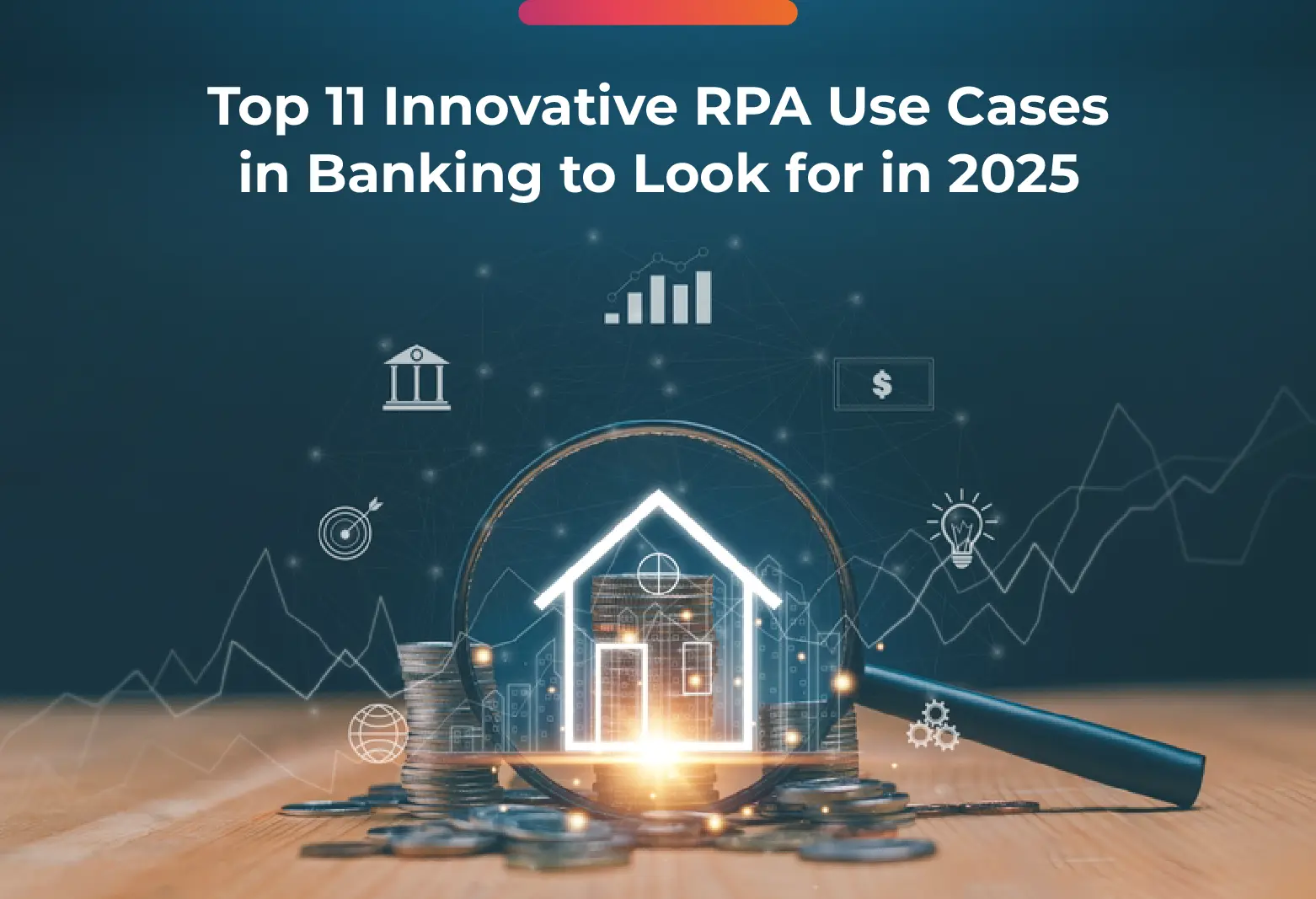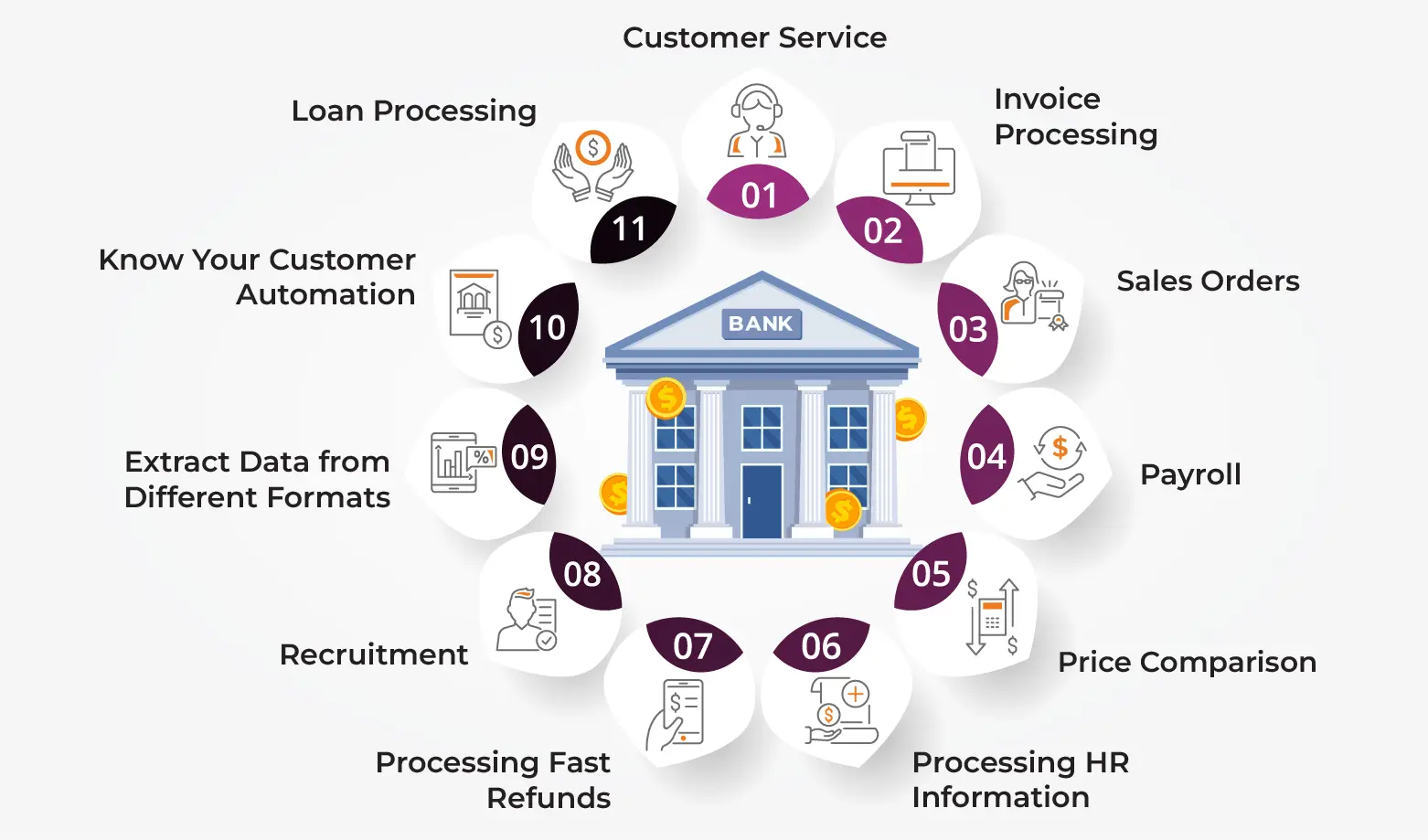Top 11 Innovative RPA Use Cases in Banking to Look for in 2025
Key Article Takeaways RPA transforms banking by automating repetitive tasks, like customer service, loan processing, invoice processing and others, to reduce manual workload and errors. Future innovations like AI, ML, and Generative AI in banking will further streamline banking operations, enabling personalised services, fraud detection, and secure transactions. [...] The post Top 11 Innovative RPA Use Cases in Banking to Look for in 2025 appeared first on AutomationEdge.

Key Article Takeaways
- RPA transforms banking by automating repetitive tasks, like customer service, loan processing, invoice processing and others, to reduce manual workload and errors.
- Future innovations like AI, ML, and Generative AI in banking will further streamline banking operations, enabling personalised services, fraud detection, and secure transactions.
- A strategic, phased approach to automation—integrating RPA with intelligent technologies—will help banks stay competitive, drive digital transformation, and enhance customer experience.
The Robotic Process Automation market is projected to grow to USD 64.47 billion by 2032. RPA is making waves as a game-changing force across industries, and the banking sector is no exception! Its surge transforms operations, boosts efficiency, and redefines workflows like never before. Robotic Process Automation (RPA) is a system that allows businesses to automate processes and tasks that employees typically carry out.
This system can work across different applications, platforms, and departments. RPA integrates well with the existing IT infrastructure and doesn’t require any additional installations. Companies don’t have to invest heavily to automate essential processes. There are several ways to use RPA effectively, and some of the top RPA use cases in banking in 2025 are-

-
Customer Service
Modern customers are accustomed to quick responses and practical solutions. It is possible to deliver the results that customers want with the help of automation. According to reports, over 60% of banking customers now anticipate that their banks will understand their unique needs. Automated customer care systems can sort queries and offer initial responses to customers. The automated system can segregate queries into different categories, such as tech department, service department, and more.
Sorting ensures the queries reach the right customer care agent for a quick resolution. There is no need for the customer’s call to be transferred from one executive to another. Customer service has several rules-based processes that can be automated and streamlined.
-
Invoice Processing
High-volume invoice processing often involves repetitive manual tasks, leading to delays and payment errors. Late or incorrect payments can disrupt vendor relationships and impact the quality of goods and services received. Some significant challenges in invoice processing include handling multiple invoice formats, consolidating financial data from various sources, and ensuring accuracy in reconciliation. According to a report, 56% of respondents spend more than 10 hours per week processing invoices.
RPA automation for enterprises automatically processes invoices once received. The paper-based invoice format can be automated using OCR. Using RPA and AI in banking can automate data input and reconciliation errors and even process confident decision-making required for invoice processing, which minimises the need for human intervention.
AutomatioEdge RPA Solution Helped HDFC Bank Processed Data Autonomously with 100% Accuracy
-
Sales Orders
Data consistency across enterprise systems is a very tedious task. Sales representatives must spend critical time entering data into the CRM and ERP systems. Finance analysts must replicate and enter the data in another system or module. This may result in duplication, produce errors and affect productivity. As per a report, around 29% of respondents identified customer responsiveness as their biggest challenge in sales order processing.
RPA in business automation streamlines sales activities by handling tasks such as sales order entry, invoicing, and database management. It eliminates duplicate data, enhances customer experience, and boosts sales team productivity by automating time-consuming processes like data entry. This allows sales employees to focus on their core responsibilities—prospecting and driving business growth.
-
Payroll
Processing payroll every month is a time-consuming, repetitive task for the HR team in every organisation, and this also requires a large volume of data entry efforts. This may result in data inaccuracy that can cause delays in payment and employee dissatisfaction. Around 58% of organisations are looking to use automation solutions to improve operational efficiency.
RPA in payroll processing can verify employee data consistency across multiple systems, validate timesheets, and load earnings and deductions. It can also automate paycheck creation, administrative benefits and reimbursements. RPA can automate payroll-related transactions from end to end to avoid inaccuracies and delays.
-
Price Comparison
Businesses often have to make purchases in bulk to manufacture products or provide services. The cost of these items can impact the company’s revenue or profits; companies constantly research online to make an informed decision.
The research process can be time-consuming and complicated, so many companies have begun using RPA. Automated System for banking doesn’t just compare prices from different vendors but can also compare product attributes and quality. Businesses can buy the best resources at the best prices possible.
-
Processing HR Information
Storing and processing HR information is a challenging task. It takes a lot of time and can be a tedious process. A successful business generates vast amounts of employee data, which can be difficult to sort and organise. The RPA in banking can collect and organise all the information your HR department requires. Information like employee history, payroll, reimbursements, and training level can all be sorted and stored through RPA.
It can handle all of the day-to-day tasks and allow your HR employees to focus on the human aspect. They can work on improving employee productivity and work culture, which can’t be handled by automation.
-
Processing Fast Refunds
A company’s reputation depends on how quickly it can process refunds. Customers want this process to be quick and seamless, but that is easier said than done. Complaints and return requests generate a lot of data, which can be tiresome to sort through. Automated banking systems deal with the matter effectively and process the refund without delay. That improves overall customer experience and has a positive impact on your reputation.
-
Recruitment
Robotic Process Automation in banking can also help with recruitment, which can help streamline the process considerably. The system can source resumes from different platforms, access value, sort through spam or undesirable applications, and other such factors.
This can streamline the recruitment process by a considerable margin. It can reduce the stress of recruiters and allow them to access every applicant more thoroughly. Automation in the banking system enables banking services to reduce email and follow-up time by 75%.
-
Extract Data from Different Formats
Data can appear in different formats, from editable text to handwritten notes. Data entry professionals struggle to read and enter the information into the system. Optical character recognition technology can easily read the information from different format sources and enter it into the system.
The entire process can be automated with little compromise in the accuracy of the information. If your business needs to collect and store information from different sources, RPA is a significant investment. Employees spend around 10% to 20% of their man-hours on recitative computer tasks like this one. You can save all of that time and direct it towards something more productive.
-
Know Your Customer Automation
Banks are turning to automation with increasing regulatory scrutiny on KYC and anti-money laundering (AML) standards and rising compliance costs. However, many hesitate to automate KYC due to the high costs of overhauling complex, interconnected legacy systems.
RPA in the KYC process offers a solution that seamlessly integrates into existing infrastructure with minimal disruption. It automates rule-based tasks such as setting up, validating, collecting, and compiling customer information, enabling employees to focus on critical reviews while improving efficiency and compliance.
-
Loan Processing
In many organisations, loan processing capacity is limited by the number of employees handling the tasks. However, banking RPA bots can streamline loan administration by automating key processes such as underwriting and application validation.
AI-powered RPA bots enhance efficiency by conducting credit checks and consolidating financial data from paper documents, bank databases, and third-party systems like nationwide credit bureaus. They generate comprehensive reports using predefined rules with all the necessary information for loan approval. This gives loan officers a complete, 360-degree view of applicants’ financial standing, enabling them to assess risks accurately and make well-informed decisions. Automation in banking operations enables banking organisations to reduce 50% TAT reduction in loan application processing.
Final Thoughts
RPA is revolutionising banking by automating repetitive tasks, improving efficiency, and enhancing compliance. Integrating AI, ML, and Generative AI will further transform the industry. AI-driven chatbots and predictive analytics enable personalised banking; ML will enhance fraud detection and streamline secure transactions.
Banks must adopt a holistic approach to stay competitive, combining RPA with intelligent automation and cloud computing. By starting small and scaling gradually, financial institutions can build a future-proof, customer-centric, and highly efficient banking ecosystem. Don’t let manual processes slow you down. Explore AutomationEdge’s RPA solutions and Book a free Consultation now!
Frequently Asked Questions
Banks automate back-office tasks like data entry, reconciliation, report generation, and compliance monitoring using RPA. AI-powered bots handle repetitive processes, improving speed and reducing human errors. Implementing RPA in back-office functions enhances productivity and operational efficiency.
The post Top 11 Innovative RPA Use Cases in Banking to Look for in 2025 appeared first on AutomationEdge.


 Editor-Admin
Editor-Admin 





